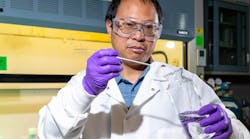Material scientists at Sandia National Laboratory have discovered a way to use citric acid, a harmless food-grade found naturally in citrus fruits (especially lemons and limes), along with carbon dioxide and water, to extract rare-earth metals from coal ash. This eliminates some of the coal ash, a residue of coal-fired power, without harming the environment while providing a stream of an important national resource.
The method, if widely adopted, could make coal ash, currently an environmental pariah, into a commercially viable product, says Guangping Xu, lead Sandia researcher on the project.
The most common acids used as chemical separators in mining—nitric, sulfuric and phosphoric acids—can extract rare-earth metals from coal ash but they generate large amounts of acidic waste, leaving the environment in worse shape than before. “These environmentally harmful acids would raise clean-up costs beyond economic feasibility in the U.S.,” says Xu.
The Sandia process uses citric acid as a carrier for rare-earth metals so they separate from coal ash, the host material. Extraction is helped along by using supercritical carbon dioxide as a solvent. The citric acid is an environmentally friendly way to holding the rare earth metals in solution.
The team found that in less than a day, an extraction process running at 158°F (70°C) and pressure at 1,100 psi (about 70 times ordinary atmospheric pressure), could remove and recover 42% of the rare-earth metals in the coal ash.
“Theoretically, an American company could use this technique to mine coal and coal byproducts for rare-earth metals and compete with Chinese mining,” says Xu. Furthermore, for U.S. national security purposes, “it is probably reasonable to have alternate sources of rare-earth metals to avoid being at the mercy of a foreign supply.”
Detoxifying coal ash for reuse alone should be worth the effort, Xu says. There’s no shortage of coal ash as a raw material. According to a 2016 study, approximately 115 million metric tons of coal combustion products are generated annually, and this includes 45 million tons of fly ash, the lightest kind of coal ash.
“If we don’t detoxify and reuse the coal ash, it will be abandoned in ponds and landfills and cost billions of dollars to clean up in the long term,” Xu notes.
This technology could open a new avenue for reusing and sequestering carbon-dioxide. The team is looking into using citric acid and supercritical carbon dioxide to mine metals from oil and gas shales that are often rich in metals.
Using existing oil and gas fracking wells, citric acid and supercritical carbon dioxide can cost-effectively mine metals while disposing of the carbon dioxide underground. Subsurface storage of the carbon dioxide should keep it from entering the atmosphere and contributing to climate change.



